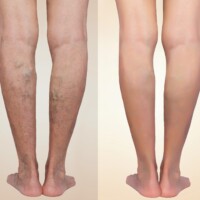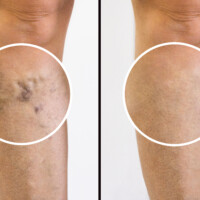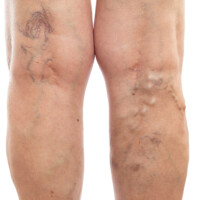Varicose Veins
What are Varicose Veins?
These are large, broken veins that protrude under the skin of the leg. They can be painful, throb, feel heavy or achy, itch, or cause ankle or calf swelling. Varicose veins can occasionally bleed or develop blood clots called phlebitis. Symptoms get worse during the day. Varicose veins can also be asymptomatic. They cannot be reversed naturally.
Varicose veins develop because the valves inside the veins that help push the blood from our legs back to our heart, weaken and fail. This increases the pressure in the veins, which then stretch like balloons. Varicose veins are common and can be large clusters, or small spider veins.
What causes Varicose Veins?
Veins are the pipes that return the blood in our legs back to the heart. Since we stand or sit with our legs below our heart during the day, gravity works against the blood going up the leg. Vein valves help push blood up the leg against gravity. Working the leg muscles, as while walking, also helps to pump blood out of the leg to the heart.
The tiny vein valves open like doors to allow blood flow toward the heart and close to prevent it from going backwards. Aging, hormonal changes associated with pregnancy and menstrual cycles, standing and sitting for long periods (i.e. nurses, hairdressers, teachers, drivers), phlebitis (e.g. blood clot) and vein trauma can cause the valves to malfunction. This condition is known as venous insufficiency and causes varicose veins.

Symptoms and Findings
Who can suffer from VaricoseVeins?
Women or men of any age can suffer from varicose veins; however, they are much more common in women, occurring 2x as often as they appear in men.
The presence of varicose veins increases with age.
What are some common symptoms?
- Pain, burning or throbbing veins
- Itching over veins
- Throb or ache over the inner thigh
- Leg heaviness or fatigue, later in the day • Leg heaviness after prolonged sitting • Leg heaviness after prolonged standing • Swelling in the calf or ankle
- Dry skin over the ankle and lower calf • Dark purple or blue colored veins
- Twisted or bulging veins like ropes
- Muscle cramping in the legs at end of day • Restless Leg Syndrome
- Skin discoloration around varicose vein
How are they Diagnosed?
A vascular provider will take your complete medical and family history, perform a detailed physical examination. A vascular ultrasound test will be done in our office to diagnose your condition and guide out treatment plan.
When should I seek treatment?
Most patients with varicose veins have symptoms and should be evaluated. If you are experiencing pain or swelling, it is time to consider your therapeutic options.
If your varicose veins are asymptomatic, without discomfort in the leg, skin color change, or swelling, then treatment is for cosmetic reasons and is effective. Our team is ready to assist you.
Treatment
What about Treatment options at The Vascular Care Group?
- Exercise, compression garments and leg elevation can improve the symptoms of varicose veins.
- Ablation: closing the broken veins and redirecting blood into healthier veins is the main treatment; There are multiple technologies for this including RFA, Venaseal glue, and Varithena foam. Your doctors determine what treatment is best for you.
- Phlebectomy: Removing veins not reachable by ablation; this is minimally invasive and effective in removing residual varicose veins after ablation.
- Sclerotherapy of spider veins closes these small veins making them invisible.
These minimally invasive, safe, and highly effective treatments are provided by board certified vascular surgeons and our support staff in our comfortable state-of-the-art outpatient center.
Your recovery requires minimal “downtime.”
Why is the Vein Center at The Vascular Care Group the right place for my evaluation and treatment?
As an IAC Accredited Vein Center and top research location for vein treatment, we are able to provide you with the newest treatments and technologies for vein disease. Our mission statement is to ensure our patients receive excellent care in a warm and caring environment.
Our staff, with over two decades of focused commitment to the treatment of vein disease, will ensure your medical needs are met and provide a treatment plan that is right for you based on your unique venous condition and anatomy.
Some final thoughts

We provide these minimally invasive, safe, and highly effective treatments under the expert supervision of our board-certified vascular surgeons at our comfortable, state-of-the-art offices.

